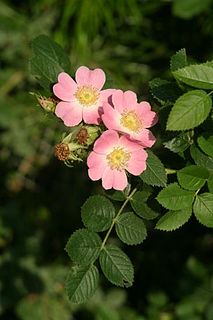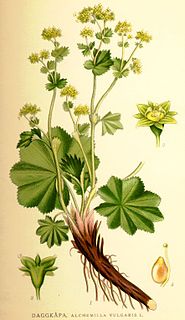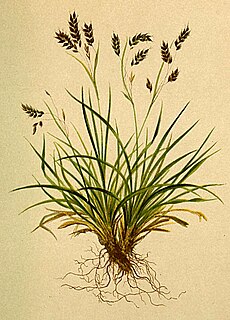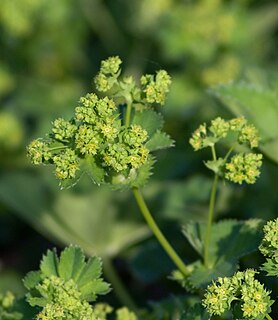
The rose subfamily Rosoideae consists of more than 850 species, including many shrubs, perennial herbs, and fruit plants such as strawberries and brambles. Only a few are annual herbs.

Alchemilla is a genus of herbaceous perennial plants in the family Rosaceae, with the common name lady's mantle applied generically as well as specifically to Alchemilla mollis when referred to as a garden plant. The plant used as a herbal tea or for medicinal usage such as gynaecological disorders is Alchemilla xanthochlora or in Middle Europe the so-called common lady's mantle Alchemilla vulgaris. There are about 700 species, the majority native to cool temperate and subarctic regions of Europe and Asia, with a few species native to the mountains of Africa and the Americas.

Alchemilla alpina, commonly known as alpine lady's-mantle, is an arctic-montane herbaceous perennial plant native to Europe and Southern Greenland.
NVC community CG10 is one of the calcicolous grassland communities in the British National Vegetation Classification system. Of the upland group of calcicolous grasslands, it is the only one with a short sward associated with heavy grazing.

Peronospora potentillae is a plant pathogen infecting strawberries. It also infects Alchemilla filicaulis.
Phoma herbarum is a fungal plant pathogen infecting various plant species, including Alchemilla vulgaris, Arabis petraea, Arenaria norvegica, Armeria maritima, Bartsia alpina, Capsella bursa-pastoris, Erysimum, Euphrasia frigida, Honckenya peploides, Matricaria maritima, Rumex longifolius, Thymus praecox and Urtica dioica.
Discosia artocreas is an ascomycete fungus that is a plant pathogen. In Iceland, it has been reported from the host species Alchemilla alpina, Betula pubescens, Geum rivale, Salix herbacea and Thalictrum alpinum.

Alchemilla vulgaris, common name Lady's mantle, is an herbaceous perennial plant in Europe and Greenland. These perennial wildflowers, members of the rose family, are sometimes grown in gardens - mainly for their leaves, which collect sparkling water droplets.

The Vatnsmýrin Nature Reserve is a protected moorland in Reykjavík, Iceland. The reserve provides a water source for Tjörnin Lake and is a nesting ground for birds. It borders the Nordic House and the University of Iceland. The area within the Reserve including drains and fences, and measures 37,026 square metres (398,540 sq ft). Eighty-three species of vascular plants are documented. Biodiversity has been inhibited due to invasive animals and plants as well as industrial waste.

Carex capillaris, the hair-like sedge, is a species of sedge found in North America and northern Eurasia including Greenland.

Alchemilla glaucescens is a species of plants belonging to the family Rosaceae.

Alchemilla glabra is a species of plants belonging to the family Rosaceae.
Alchemilla glomerulans is a species of plants belonging to the family Rosaceae.

Alchemilla monticola, also called hairy lady's mantle, is a species of plant belonging to the family Rosaceae.

Alchemilla xanthochlora is a species of plants belonging to the family Rosaceae.

Alchemilla subcrenata is a species of flowering plant belonging to the family Rosaceae.
Alchemilla propinqua is a species of flowering plant belonging to the family Rosaceae.

Carex myosuroides, the mouse-tail bog sedge, is a species of sedge with a circumboreal distribution. It is the only known sedge to have ectomycorrhizal associations.

Alchemilla flabellata, the fan lady's mantle, is a species of flowering plant in the family Rosaceae. It is native to central and southern Europe, Ukraine, and possibly central European Russia, and is locally extinct in Czechoslovakia. It prefers to grow in mountainous areas in calcareous meadows.














